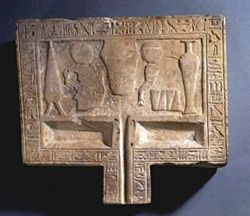
The cult in the temple in Egypt was always a state affair. The king was actually the person who carried out the rituals in every temple. Because of his divine nature, he was the only one who could associate with the gods. The reliefs in the temples, which show what went on and which texts were spoken during the rituals, always depict the king in this divine role. He was the one who brought offerings to the gods and carried out the other rituals. On festival days he did in fact carry out these duties in person, but in everyday practice it was the high priests who carried out this sacral role in the name of the king and stood in for him. The temple was the "god's house". In the innermost part of the temple lived the god. The priests were his or her domestic staff. The cult statue was located in a shrine in the innermost chapel. Every morning the god was woken with hymns, washed, dressed, censed, bedecked with floral wreaths and fed. The entire daily ritual was designed to maintain the order of creation, Maat. Everything depended on this, not only the regular course of day and night, the seasons and the arrival of the inundation, but also social and ethical order. Ordinary people were not allowed into the innermost parts of the temple. They were only permitted in the large forecourt, where "the prayers of gods and men were heard". This was where private individuals were able to leave their votive offerings. On festival days, of which there were many, the cult statue would leave the temple in a procession. It would be carried outside on the shoulders of the priests in a shrine on a processional bark, also kept in the chapel. This was the ordinary people's chance to ask the will of the god by means of an oracle. The temple cult in the time of Akhenaton in Akhetaton (El-‘Amarna) was very different and harked back to the worship of Harakhty in the sun temple of Abu Ghurab (Old Kingdom). The cult of the god Aton took place in the open and was directed towards his image on earth, Akhenaton. In various museum collections are many fragments of reliefs which originally came from temples, as well as cult objects, statues of gods and statues of the king depicted bringing an offering.